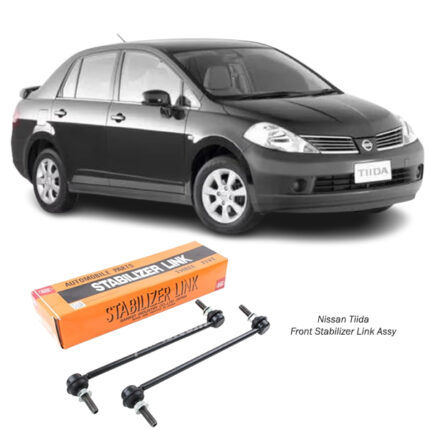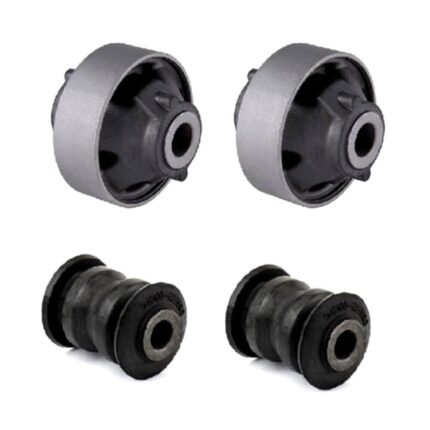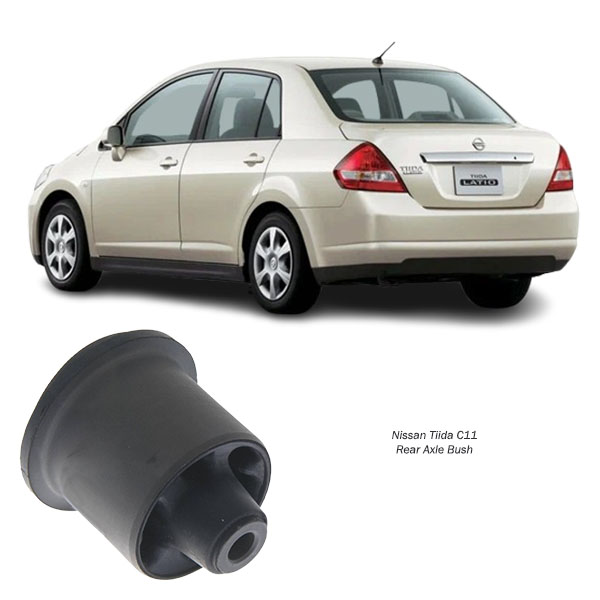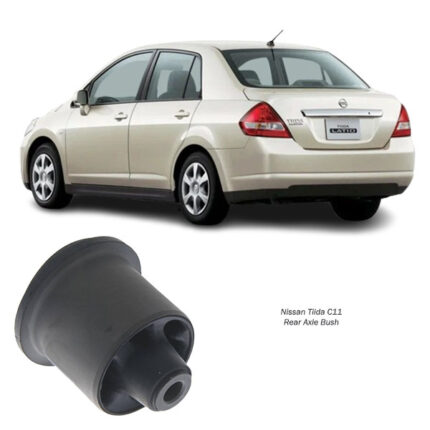Get Nissan Tiida c11 Rear Axle Bush 55501-BC64B in Kenya
In the intricate world of machines and movement, every component plays a vital role. Some parts get the spotlight – the powerful engines, the sleek designs, the innovative technology. But tucked quietly beneath all the motion and noise is a silent performer: the Rear Axle Bush. 🧩
This small yet mighty part is responsible for much more than meets the eye. Let’s dive into the world of the rear axle bush and explore why it’s so essential, what it does, and what happens when it begins to fail.
What is a Rear Axle Bush? 🤔
A rear axle bush is a flexible rubber or polyurethane component that acts as a cushion between the rear axle and the frame. It absorbs shocks, controls vibration, and allows just enough movement for the suspension to work smoothly without transferring all the harshness to the rest of the system.
Think of it like a shock-absorbing joint 👣— it helps maintain balance, comfort, and structural alignment.
The Role of the Rear Axle Bush 🧭
Here’s what a rear axle bush does, in simple terms:
-
Absorbs Vibration 🌀
When motion happens over uneven surfaces, a lot of vibration is generated. The bush softens these impacts, ensuring that vibration doesn’t rattle the entire structure. -
Reduces Noise 🔇
Metal-on-metal contact can be incredibly noisy. The rear axle bush eliminates that by acting as a sound insulator. -
Allows Controlled Movement 🔄
While movement is necessary, too much can be dangerous. The bush permits just the right amount of movement to allow flexibility without compromising stability. -
Supports Alignment 📏
It helps maintain the correct alignment of the rear axle with the rest of the system, ensuring smooth operation.
Materials: Rubber vs Polyurethane 🧪
Most rear axle bushes are made of either rubber or polyurethane.
-
Rubber Bushes 🧽
These are softer and offer better cushioning and comfort. They’re quiet and flexible but tend to wear out faster. -
Polyurethane Bushes 🧱
These are tougher and last longer. They offer better performance in high-stress environments but can be slightly noisier and stiffer.
The choice depends on what balance you’re looking for – comfort or durability.
Signs of a Worn Rear Axle Bush 🚨
Just like any other component, rear axle bushes wear out over time. When they start to fail, the symptoms might be subtle at first but grow noticeable over time:
-
Clunking or Knocking Noises 🔊
You might hear unusual sounds, especially during acceleration, braking, or going over bumps. -
Excessive Vibration 🔥
A worn bush won’t absorb shocks well, leading to vibrations that you can feel. -
Poor Handling 🧭
The system may feel loose or unstable, especially when turning or shifting weight. -
Uneven Wear on Other Components ⚖️
Misalignment caused by bad bushes can put pressure on other parts, causing premature wear.
Why Replacement is Crucial 🛑
Neglecting a failing rear axle bush can lead to more significant problems. Not only does it affect the comfort and safety of the system, but it can also strain and damage other components. Replacing a worn bush early can prevent a chain reaction of wear and tear 🔗.
It’s a small investment that protects the integrity of the whole setup 💼.
The Replacement Process 🔁
Swapping out a rear axle bush involves:
-
Lifting and Securing the System 🏗️
The structure needs to be safely lifted for access. -
Removing the Rear Axle Assembly 🧲
Parts around the axle are removed to expose the bush. -
Extracting the Old Bush 🛠️
Depending on wear, this could be straightforward or require some pressing or cutting. -
Installing the New Bush 🌟
The new bush is fitted, often with lubrication or pressing tools. -
Reassembling Everything 🔧
All parts are reattached, and alignment is double-checked.
This process should be handled by professionals or skilled technicians, as precision is key 🧑🔬.
Upgrading for Better Performance 🏁
If you’re looking to enhance performance, you might consider upgrading to polyurethane bushes. These offer:
-
Greater Lifespan ⏳
-
Better Handling 🎯
-
Improved Feedback 📡
However, they may transmit slightly more vibration compared to rubber. It all comes down to your priorities: smoothness vs performance.
Preventive Maintenance Tips 🧼
To extend the life of your rear axle bush and avoid premature failure:
-
Inspect Regularly 🔍
Visual checks during maintenance can catch early signs of wear. -
Avoid Harsh Conditions When Possible 🌧️
Extreme weather, salt, and debris can accelerate wear. -
Stick to Routine Servicing 📅
Follow scheduled maintenance to ensure everything stays in top shape. -
Listen to Your Machine 👂
Unusual noises or changes in feel often signal trouble.
The Bottom Line 💡
The rear axle bush may be small and easily overlooked, but its role is anything but minor. It’s a guardian of balance ⚖️, a buffer of force 💥, and a silent partner in smooth, stable movement.
Taking care of this humble part means a quieter, safer, and longer-lasting system overall. Whether for comfort, control, or protection—this tiny cushion packs a powerful punch 💪
Follow us on Facebook for more parts.




